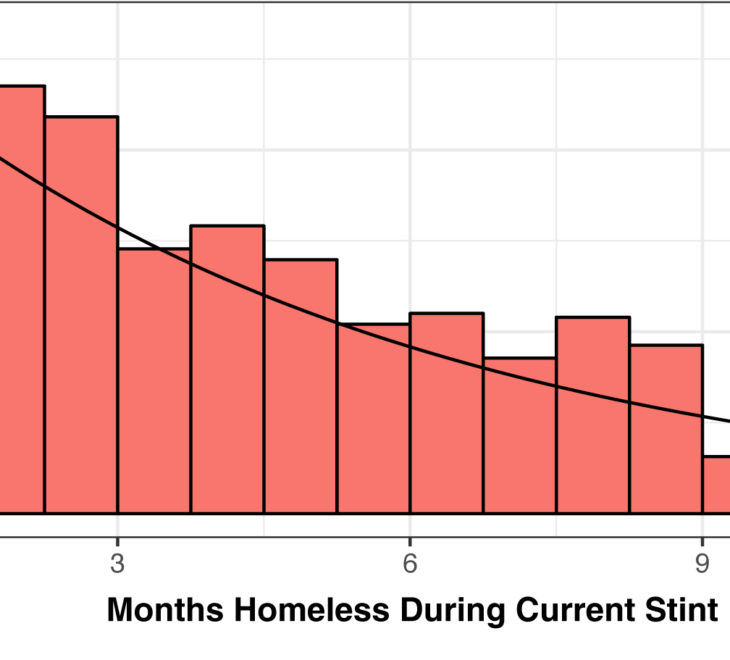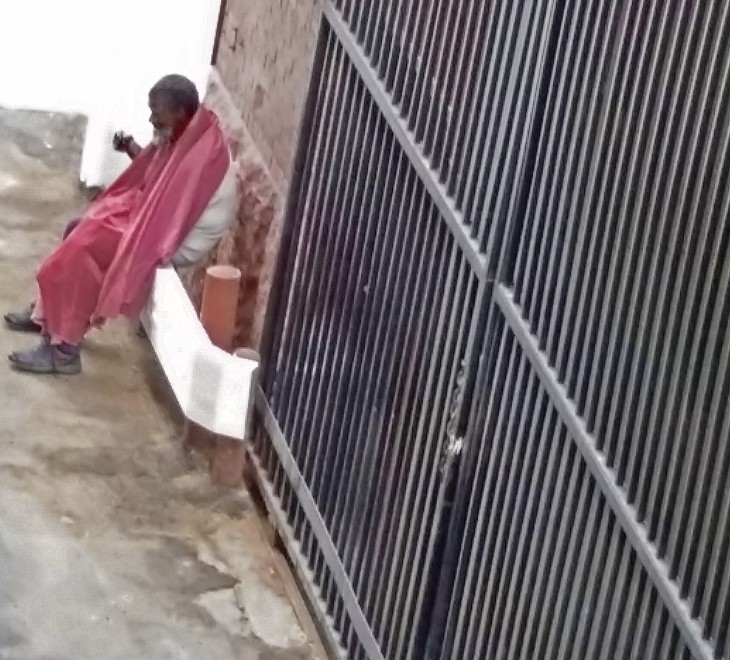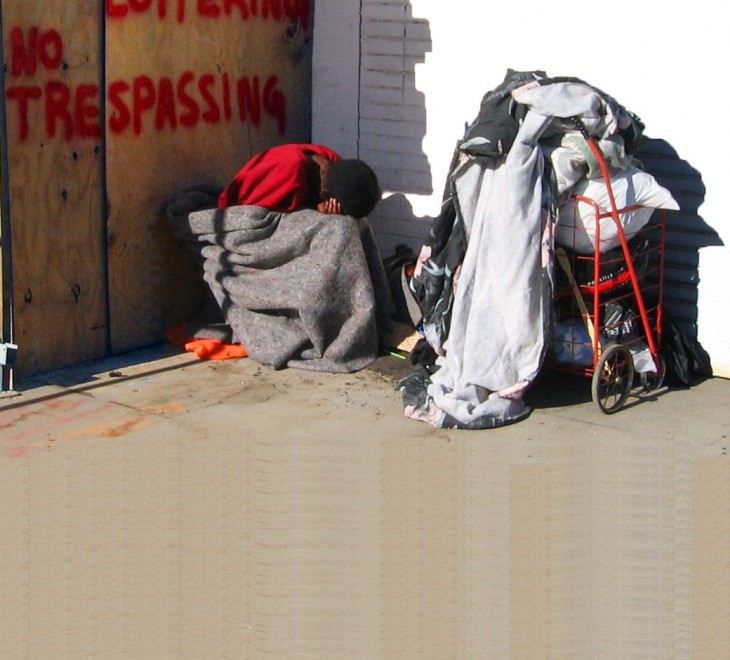Overview of Data:
One-hundred-seven files from homeless street counts, demographic surveys of unsheltered individuals, and intake data for shelter residents, along with supporting documentation are available in this data library. These open source, de-identified person records provided by the Los Angeles Homeless Services Authority (LAHSA) are a resource for homeless research.
LAHSA conducts counts of homeless residents in Los Angeles County, excluding the cities of Glendale, Long Beach and Pasadena, which conduct their own counts. From 2005 to 2015, the counts were conducted every other year. Since 2015, the counts have been conducted every year, except for 2021. This data library includes records from 2007 through 2023.
Roughly 70 percent of the point-in-time population lives in unsheltered locations such as sidewalks, vehicles, or road embankments. These individuals are counted by volunteers who are assigned to carry out the count in census tracts throughout the county. Information about the attributes of unsheltered individuals is obtained through a demographic survey of a sample of this population. Since 2013, information about the other 30 percent of individuals who are in shelters is obtained from Homeless Management Information System (HMIS) records from the month preceding the count, which provide data about both their attributes and the number residing in shelters on a given night. Prior to 2013, individuals in shelters were counted but not described separately. The demographic survey and HMIS records provide separate sources of information about the attributes of homeless individuals from 2013 onwards.
HMIS records include the complete universe of sheltered individuals – roughly 10,000 to 14,000 records depending on the year. Even though the demographic survey represents a larger population, there are fewer records – 3,000 to 5,000 depending on the year – because this information must be obtained through personal surveys. Differences between the populations shown in HMIS records compared to the demographic survey include larger shares of women, children and newly homeless individuals in HMIS records.
Demographic survey information for most years is presented in two formats – household and individual. In the household format, information for all of the individuals in a household unit is presented in a single row. In the individual format, information for each individual is presented in a separate row.
This data library includes the original, de-identified records from the street counts conducted from 2007 to 2023. The purpose of the street count is to determine the total number of unsheltered individuals. Each file contains a list of the census tracts where counts were conducted and results from each tract, and beginning in 2009, breaks out the number of homeless individuals, vehicles, tents and shelters that were enumerated. A separate file of street count information was provided for youth beginning in 2009. Beginning in 2016, the youth street count and demographic surveys were combined, with the surveyed population also representing the counted population.
Up through 2015, the street count used census tract boundaries and numbering from the 2000 census. Beginning in 2016, the street count used tract boundaries and numbering from the 2010 census.
Paul Beeman from UCLA has produced standardized versions of records for many of the homeless count files, with consistent labeling and a codebook for each data set. This includes demographic surveys of unsheltered individuals from 2011 to 2017, and HMIS records used in the 2016 and 2017 counts. In addition, he produced a multi-year data set containing a reduced set of variables that are available in all records from 2011 to 2017 for both sheltered and unsheltered individuals.
Links for downloading each data set are provided below, moving sequentially from 2023 to earlier years. Each data set is available in the original, de-identified form provided by LAHSA with the questionnaire used to obtain the information, along with a standardized version codebook for those years where they are available. In addition the methodology report explaining the statistical procedures used for each homeless and all available codebooks are provided.
2023 Data
- 2023 Homeless Count Unsheltered Demographic Survey
- 2023 Homeless Count Demographic Survey Data Dictionary
- 2023 Homeless Count Demographic Survey Questionnaire
- 2023 HMIS Records of Sheltered Individuals
- 2023 HMIS Data Dictionary
- 2023 LAHSA Briefing on Homeless Count
2022 Data
- 2022 Homeless Count Unsheltered Demographic Survey
- 2022 HMIS Records of Sheltered Individuals
- 2022 Street Count Results by Census Tract
- 2022 Data Dictionary for Demographic Survey
- 2022 LAHSA’s Occupancy Factors for Cars, Vans, RVs, Tents, and Makeshift Shelters
- 2022 GIS Shape Files for Homeless Count Census Tracts
- 2022 Methodology Report
2020 Data
- 2020 Homeless Count Unsheltered Demographic Survey
- 2020 HMIS Records of Sheltered Individuals
- 2020 Street Count Results by Census Tract
- 2020 Data Dictionary for Demographic Survey
- 2020 LAHSA’s Occupancy Factors for Cars, Vans, RVs, Tents, and Makeshift Shelters
- 2020 GIS Shape Files for Homeless Count Census Tracts
- 2020 Methodology Report
2019 Data
- 2019 Homeless Count Unsheltered Adults Demographic Survey – Households
- 2019 Homeless Count Unsheltered Adults Demographic Survey – Individuals
2019 Homeless Count Unsheltered Youth Demographic Survey – Households - 2019 Homeless Count Unsheltered Youth Demographic Survey – Individuals
- 2019 HMIS Records of Sheltered Individuals
- 2019 Street Count Results by Census Tract
- 2019 Data Dictionary for Adult Demographic Survey – Household Files
- 2019 Data Dictionary for Adult Demographic Survey – Individual File
- 2019 Data Dictionary for Youth Demographic Survey – Households
- 2019 Data Dictionary for Youth Demographic Survey – Individuals
- 2019 Data Dictionary for HMIS Records of Sheltered Individuals
- 2019 Unsheltered Adult Demographic Survey Questionnaire
- 2019 Unsheltered Youth Demographic Survey Questionnaire
- 2019 Occupancy Factors for Cars, Vans, RVs, Tents, and Makeshift Shelters
2018 Data
- 2018 Homeless Count Unsheltered Adults Demographic Survey – Households
- 2018 Homeless Count Unsheltered Adults Demographic Survey – Individuals
- 2018 Homeless Count Unsheltered Youth Demographic Survey – Households
- 2018 Homeless Count Unsheltered Youth Demographic Survey – Individuals
- 2018 HMIS Records of Sheltered Individuals
- 2018 Street Count Results by Census Tract
- 2018 Data Dictionary for Adult Demographic Survey
- 2018 Data Dictionary for Youth Demographic Survey
- 2018 Data Dictionary for HMIS Records of Sheltered Individuals
- 2018 Unsheltered Adult Demographic Survey Questionnaire
- 2018 Unsheltered Youth Demographic Survey Questionnaire
- 2018 Methodology white paper
Multi-Year Data Set 2011 to 2017
- 2011 to 2017 Standardized Data from Demographic Surveys and HMIS Records
- Codebook for Multi-Year Standardized Data Set
2017 Data
- 2017 Homeless Count Unsheltered Adults Demographic Survey – Individuals
- 2017 Homeless Count Unsheltered Youth Demographic Survey – Individuals
- 2017 Homeless Count Unsheltered Adults and Youth Demographic Survey – Individuals – Standardized Records
- 2017 HMIS Records of Sheltered Individuals
- 2017 HMIS Records of Sheltered Individuals – Standardized Records
- 2017 Street Count Results by Census Tract
- 2017 Unsheltered Adult Demographic Survey Questionnaire
- 2017 Unsheltered Youth Demographic Survey Questionnaire
- 2017 Adult Demographic Survey Variables, Frequency and Codes
- 2017 Youth Demographic Survey Variables, Frequency and Codes
- 2017 Codebook for Standardized Records from the Demographic Survey of Unsheltered Individuals
- 2017 HMIS Intake and Enrollment Form
- 2017 Codebook for Standardized HMIS Records of Sheltered Individuals
- 2017 Methodology White Paper
2016 Data
- 2016 Homeless Count Unsheltered Adult and Youth Demographic Survey – Individuals
- 2016 Homeless Count Unsheltered Adult and Youth Demographic Survey – Individuals – Standardized Records
- 2016 HMIS Records of Sheltered Individuals in Adult Households
- 2016 HMIS Records of Sheltered Individuals in Youth Households
- 2016 HMIS Records of Sheltered Adults and Youth – Standardized Records
- 2016 Street Count Results by Census Tract
- 2016 Youth Street Count & Demographic Survey Results
- 2016 Unsheltered Adult and Youth Demographic Survey Questionnaire
- 2016 Codebook for Standardized Records from the Demographic Survey of Unsheltered Individuals
- 2016 Codebook for Standardized HMIS Records of Sheltered Individuals
- 2016 Methodology White Paper
2015 Data
- 2015 Homeless Count Unsheltered Adult and Youth Demographic Survey – Individuals
- 2015 Homeless Count Unsheltered Adult and Youth Demographic Survey – Individuals – Standardized Records
- 2015 HMIS Records of Sheltered Individuals
- 2015 Street Count Results by Census Tract
- 2015 Youth Street Count Results by Census Tract
- 2015 Unsheltered Adult and Youth Demographic Survey Questionnaire
- 2015 Codebook for Standardized Records from the Demographic Survey of Unsheltered Individuals
- 2015 Methodology White Paper
2013 Data
- 2013 Homeless Count Unsheltered Adult and Youth Demographic Survey – Individuals
- 2013 Homeless Count Unsheltered Adult and Youth Demographic Survey – Individuals – Standardized Records
- 2013 HMIS Records of Sheltered Individuals
- 2013 Street Count Results by Census Tract
- 2013 Youth Street Count Results by Census Tract
- 2013 Unsheltered Adult and Youth Demographic Survey Questionnaire
- 2013 Demographic Survey Codebook
- 2013 Codebook for Standardized Records from the Demographic Survey of Unsheltered Individuals
- 2013 Methodology White Paper
2011 Data
- 2011 Homeless Count Unsheltered Adult and Youth Demographic Survey – Individuals
- 2011 Homeless Count Unsheltered Adult and Youth Demographic Survey – Individuals – Standardized Records
- 2011 Street Count Results by Census Tract
- 2011 Youth Street Count Results by Census Tract
- 2011 Unsheltered Adult and Youth Demographic Survey Questionnaire
- 2011 Demographic Survey Codebook
- 2011 Codebook for Standardized Records from the Demographic Survey of Unsheltered Individuals
- 2011 Methodology White Paper
2009 Data
- 2009 Homeless Count Unsheltered Adult and Youth Demographic Survey – Individuals
- 2009 Street Count Results by Census Tract
- 2009 Youth Street Count Results by Census Tract
- 2009 Unsheltered Adult and Youth Demographic Survey Questionnaire
- 2009 Methodology white paper
- Discussion of Differences in Count Results from 2007 to 2009













